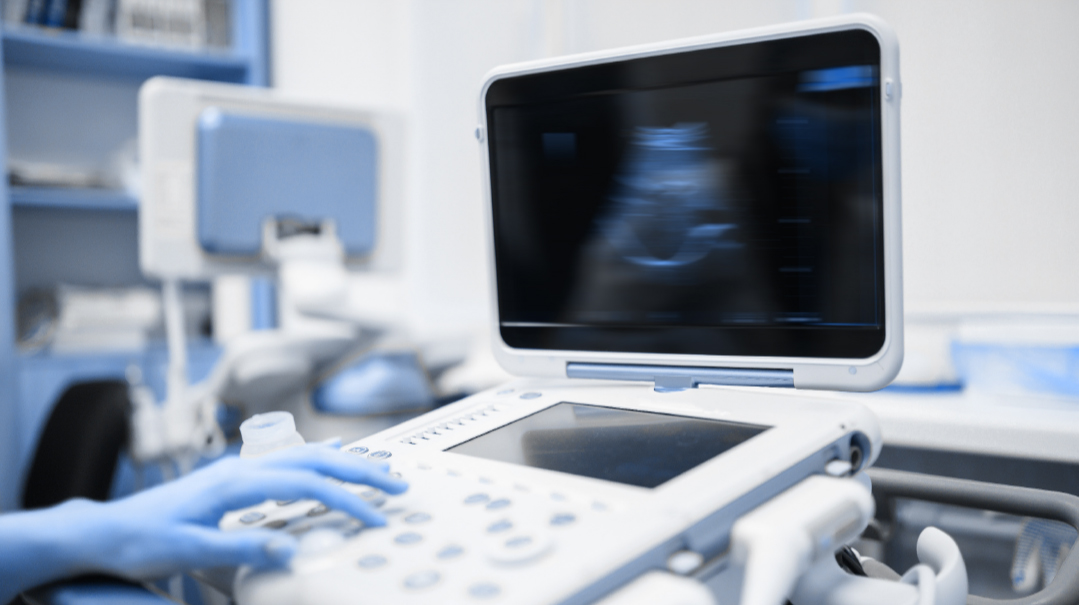So You Want to Be a… Sonographer
| June 18, 2024Good sonographers possess excellent technical skills, eye-hand coordination, and attention to detail

What will I be doing all day?
A diagnostic medical sonographer helps physicians diagnose and monitor various medical conditions by using ultrasound imaging machines that produce sound waves inside the body to generate images of internal organs, tissues, or blood flow.
Responsibilities include obtaining patient medical histories, preparing the patient for the ultrasound procedure, operating the equipment, analyzing the images, and collaborating with physicians, radiologists, and other medical professionals to discuss the results.
What kind of career options do I have?
A sonographer can choose to specialize in a range of areas. Common specialties include OB/GYN, abdomen, and superficial structures, echocardiography, vascular technology, musculoskeletal, and neurosonography.
Sonographers work in a variety of health care settings, such as hospitals, private clinics, and diagnostic imaging centers.
What kind of training do I need?
To become a diagnostic medical sonographer, one must complete a two-year associate’s degree program. There are also four-year bachelor’s degree options, as well as a one-year training program for people who already have a degree in the health fields. In addition, the American Registry for Diagnostic Medical Sonography (ARDMS) offers specialized accreditations, which require passing certification exams.
Do I have the personality for it?
Good sonographers possess excellent technical skills, eye-hand coordination, and attention to detail. In addition, they must have good communication and interpersonal skills: patience, compassion, and understanding.
What can I expect to make?
Average salary in the US: $85,000 (salary can vary widely based on location)
TALES FROM THE TRENCHES
TZIPPY FARKAS-BALIN
Brooklyn, New York
Ultrasound Technologist, Lenox Hill Hospital MFM (Maternal Fetal Medicine), New York, New York
Graduated From: B.S. in Radiological Sciences, St. Francis College; DMS (Diagnostic Medical Sonographer), CAHE (Center for Allied Health Education)
Years in Field: 11
My Typical Day at Work
I typically clock in at 9 a.m. at Lenox Hill’s MFM department. I head to my ultrasound room, turn on the machine, and make sure my room is ready for a patient. I then head to the front desk, where all the patients’ charts are (we still have paper charts at Lenox Hill). In our department, whichever technologist is ready takes the next available chart, regardless of what type of exam it is. Some ultrasounds are quick, such as dating exams (performed early in the pregnancy to determinate a fetal heartbeat and how far along a patient is), and second- and third-trimester biophysical profiles, which look at fetal growth and fluid amount and ensure the baby is moving and practicing breathing motions. Other exams take longer and require more precision, such as early or late anatomy scans (usually done around 16 and 21 weeks, where we check to make sure every organ is working and growing properly).
Once I take a chart, I head back to my ultrasound room and review the previous report so I know exactly what is needed for the current sonogram. I then enter the patient’s information into the ultrasound machine, head to the waiting room to call my patient, and bring her and whomever is accompanying her into the room.
I start by introducing myself, tell them what exam we are going to do, and remind them of my role, and that the perinatologist (an OB-GYN who specializes in high-risk pregnancies and fetal ultrasounds) will review the results once we are done. I’ve learned early on to make everyone aware of this prior to starting the exam; if I say it after I start scanning, they automatically assume something is wrong. (Unfortunately, I’ve learned this the hard way.) Also, this way if, chas v’shalom, we do find something wrong, I can simply “remind them” afterward that, as I’ve already said, the doctor will discuss the results, without causing alarm.
Depending on what type of exam we are doing, it can take anywhere between ten minutes to an hour or more, especially if we find something wrong. Once I’m finished scanning, I head out to a computer station where I review my images, to make sure I have what I need and that the images are good enough for the doctor. I type up a report of the visit, including measurements and calculations and anything noted out of the ordinary. I then review the images with the doctor and present my patient and ultrasound findings. Depending on the results, the doctor may scan the patient himself, or tell us to bring the patient to his office where he discusses the findings and answers any questions they may have. I then sanitize the exam table and instruments and make sure the room is properly cleaned for the next patient. On a typical eight-hour shift, we see approximately 12 patients.
Sonographers are also required to make sure each of our individual rooms are fully stocked with appropriate supplies, such as gloves, drape sheets, ultrasound gel, and exam table paper.
Oops! We could not locate your form.







